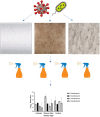Essential Oil Disinfectant Efficacy Against SARS-CoV-2 Microbial Surrogates
- PMID: 34970529
- PMCID: PMC8712468
- DOI: 10.3389/fpubh.2021.783832
Essential Oil Disinfectant Efficacy Against SARS-CoV-2 Microbial Surrogates
Abstract
Reports of COVID-19 cases potentially attributed to fomite transmission led to the extensive use of various disinfectants to control viral spread. Alternative disinfectants, such as essential oils, have emerged as a potential antimicrobial. Four essential oil blends were tested on three different surfaces inoculated with a coronavirus surrogate, bacteriophage Phi 6, and a bacterial indicator, Staphylococcus aureus. Log10 concentration reductions were analyzed using GraphPad Prism software. Data collected in this study show that the application of dilute essential oil disinfectants using a spray delivery device is an effective way to reduce concentrations of bacterial and viral microorganisms on ceramic, stainless steel, and laminate surfaces. Surrogate viruses were reduced up to 6 log10 PFU and bacterial were reduced up to 4 log10 CFU. Although surfaces are no longer considered a high risk fomite for COVID-19 transmission, the disinfection of microorganisms on surfaces remains an important consideration for high touch areas in hospitals, waiting rooms, etc. The application of spray disinfectants, based on essential oil blends, provides a rapid and effective means to reduce microbial contamination on high-touched surfaces.
Keywords: SARS-CoV-2; coronavirus; essential oil; surface; surrogate.
Copyright © 2021 Bailey, Curcic, Biros, Erdogmuş, Bac and Sacco.
Conflict of interest statement
The authors declare that the research was conducted in the absence of any commercial or financial relationships that could be construed as a potential conflict of interest.
Figures
References
-
- Cadnum JL, Jencson AL, Livingston SH Li DF, Redmond SN, Pearlmutter B, et al. . Evaluation of an electrostatic spray disinfectant technology for rapid decontamination of portable equipment and large open areas in the era of SARS-CoV-2. Am J Infect Control. (2020) 48:951–4. 10.1016/j.ajic.2020.06.002 - DOI - PMC - PubMed
Publication types
MeSH terms
Substances
LinkOut - more resources
Full Text Sources
Medical
Molecular Biology Databases
Miscellaneous




